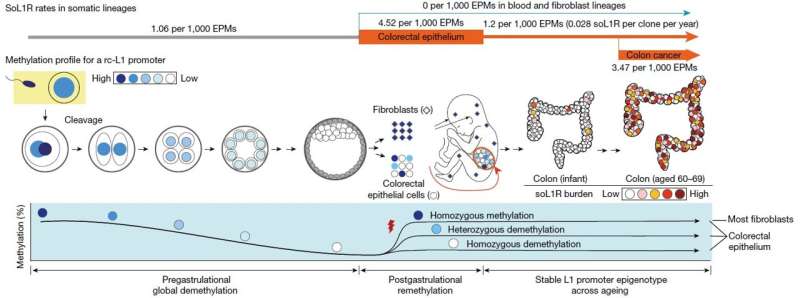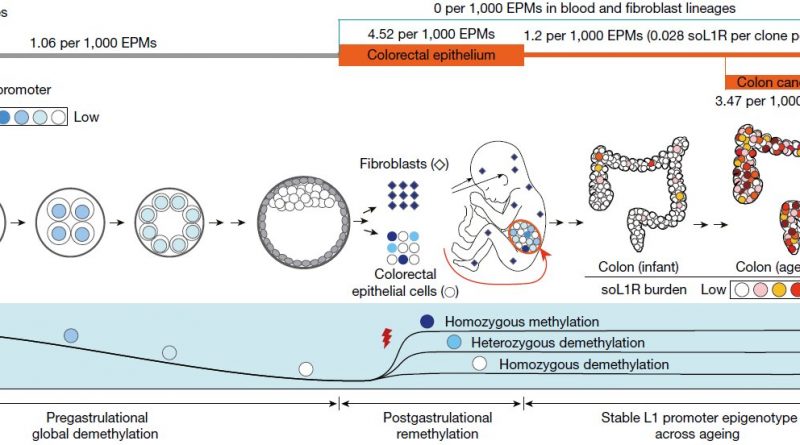Jumping genes found to alter human colon genomes, offering insights into aging and tumorigenesis

The Korea Advanced Institute of Science and Technology (KAIST) and their collaborators have conducted a groundbreaking study targeting “jumping genes” in the entire genomes of the human large intestine.
Published in Nature, the research unveils the surprising activity of “Long interspersed nuclear element-1 (L1),” a type of jumping gene previously thought to be mostly dormant in human genomes. The study shows that L1 genes can become activated and disrupt genomic functions throughout an individual’s lifetime, particularly in the colorectal epithelium.
With approximately 500,000 L1 jumping genes, accounting for 17% of the human genome, they have long been recognized for their contribution to the evolution of the human species by introducing “disruptive innovation” to genome sequences. Until now, it was believed that most L1 elements had lost their ability to jump in normal tissues of modern humans.
However, this study reveals that some L1 jumping genes can be widely activated in normal cells, leading to the accumulation of genomic mutations over an individual’s lifetime. The rate of L1 jumping and resulting genomic changes vary among different cell types, with a notable concentration observed in aged colon epithelial cells. The study illustrates that every colonic epithelial cell experiences an L1 jumping event by the age of 40 on average.
The research, led by co-first authors Chang Hyun Nam (a graduate student at KAIST) and Dr. Jeonghwan Youk (former graduate student at KAIST and assistant clinical professor at Seoul National University Hospital), involved the analysis of whole-genome sequences from 899 single cells obtained from skin (fibroblasts), blood, and colon epithelial tissues collected from 28 individuals. The study uncovers the activation of L1 jumping genes in normal cells, resulting in the gradual accumulation of genomic mutations over time.
Additionally, the team explored epigenomic (DNA methylation) sequences to understand the mechanism behind L1 jumping gene activation. They found that cells with activated L1 jumping genes exhibit epigenetic instability, suggesting the critical role of epigenetic changes in regulating L1 jumping gene activity. Most of these epigenomic instabilities were found to arise during the early stages of embryogenesis. The study provides valuable insights into the aging process and the development of diseases in human colorectal tissues.

“This study illustrates that genomic damage in normal cells is acquired not only through exposure to carcinogens but also through the activity of endogenous components whose impact was previously unclear. Genomes of apparently healthy aged cells, particularly in the colorectal epithelium, become mosaic due to the activity of L1 jumping genes,” said Prof. Young Seok Ju at KAIST.
“We emphasize the essential and ongoing collaboration among researchers in clinical medicine and basic medical sciences,” said Prof. Min Jung Kim of the Department of Surgery at Seoul National University Hospital. “This case highlights the critical role of systematically collected human tissues from clinical settings in unraveling the complex process of disease development in humans.”
“I am delighted that the research team’s advancements in single-cell genome technology have come to fruition. We will persistently strive to lead in single-cell genome technology,” said Prof. Hyun Woo Kwon of the Department of Nuclear Medicine at Korea University School of Medicine.
More information:
Chang Hyun Nam et al, Widespread somatic L1 retrotransposition in normal colorectal epithelium, Nature (2023). DOI: 10.1038/s41586-023-06046-z
Journal information:
Nature
Source: Read Full Article
